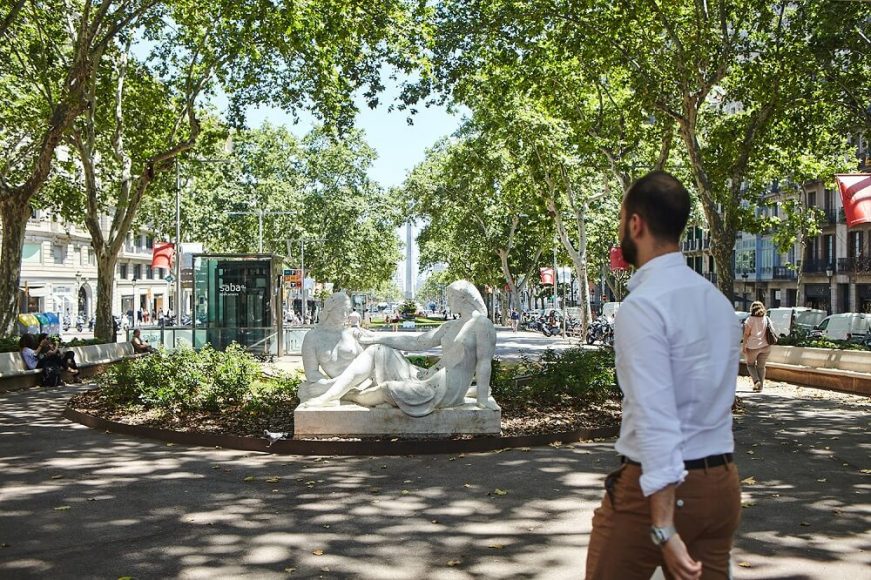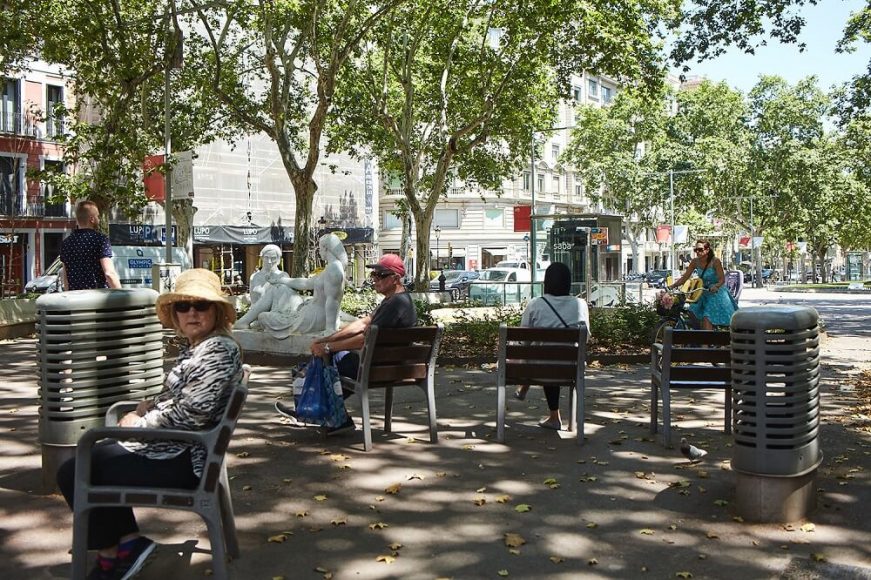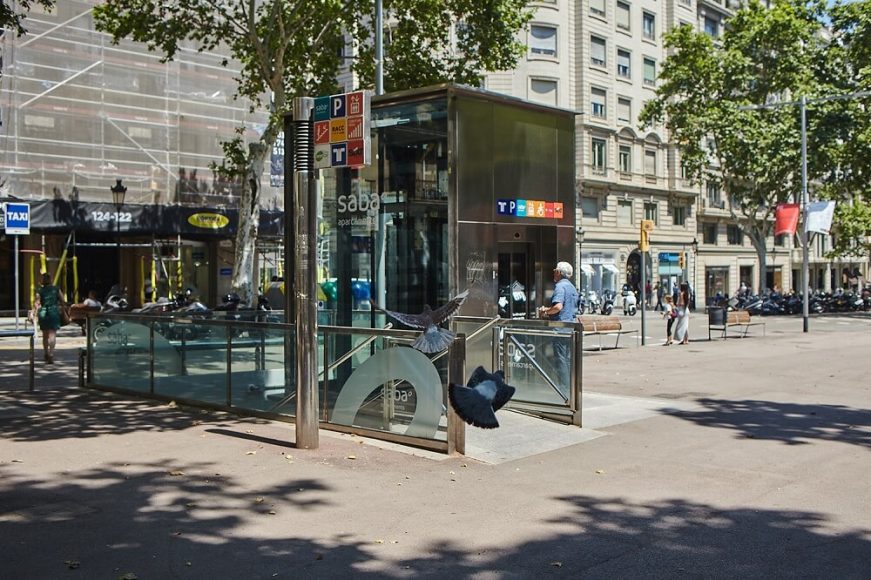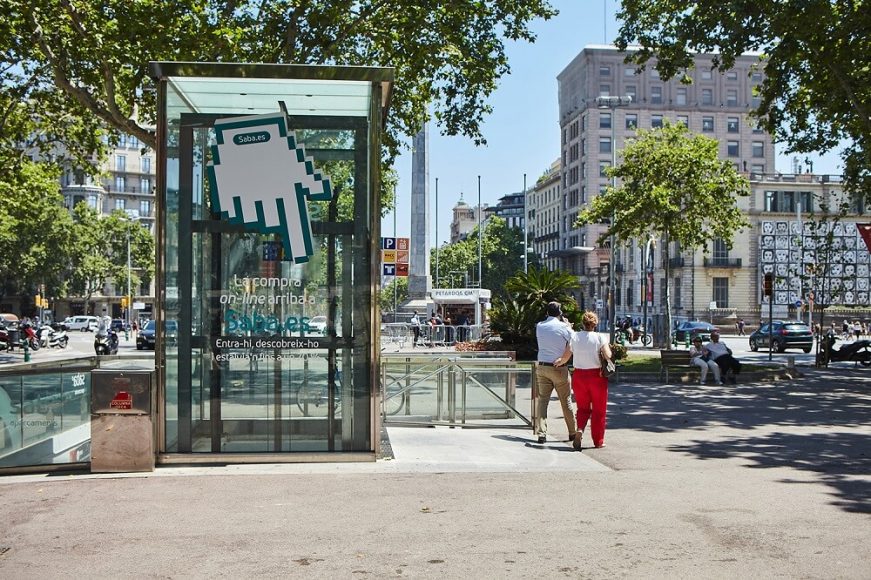An old couple is sitting on one of the benches from the highest part of Jardinets de Gràcia. This is something they do every afternoon. The old lady has an air of distinction and elegance in the way she wears her clothes –settled on her gaunt body– and her white hairstyle, combed backwards. The old man walks a bit more upright than her and looks as if he has gathered just enough strength to carry a snack bag. The bag contains a sandwich and some fruit that they will enjoy under the lush shade of the banana trees, amidst the piercing sound of incoming and outgoing traffic. To their backs, there stands Casa Fuster, an enchanted –and delightful– castle of sorts where Catalan poet Salvador Espriu lived. The place has been converted into a hotel with a watchman outside (top-hat on his head, standing straight) and the warm lights, orangy inside, seduce the passer-by, like a billboard saying: “this place is so enjoyable, as if you were in your mom’s womb”.
From the vantage point of the benches in Jardinets de Gràcia, you come to the conclusion that the streets of Barcelona are crisscrossed with buses and bikes. An endless waltz-like flow of traffic with horns blasting. Strictly speaking, this place is called, officially, Jardinets Salvador Espriu, one of Catalonia’s most significant post-war writers and outstanding poet. This is a welcoming place, a nice place to stop and stay for a while, as if you were reading a book of poems. The Jardinets are the gateway to Gran de Gràcia, the historical and popular Gràcia street, which you bump into as you leave the bourgeois and aristocratic Passeig de Gràcia. On both sides of the street, bank branches, jewelers, opticians, state agents’, departments of the Generalitat, the Catalan government and plastic surgery clinics ready to open their doors. What would Espriu have to say about this display of businesses and new services? The very thought of it is just funny.
The old couple look like a traditional Gràcia married couple, in that they repeat the same ritual every afternoon since they retired, their children grew up and their duties became more lenient. After the final bite to her biscuit, the old woman starts reading a magazine. Close to the bench they are sitting on, stands one of the three sculptures weaving through the Jardinets. It’s called L’Empordà. Oda nova a Barcelona (1903-1991), by Ernest Maragall i Noble, the son of the poet Joan Maragall. The sculpture represents a naked young girl next to another one attired in thin clothing, facing each other. The sculpture was created to commemorate the centenary of the birth of Maragall (1960) but for years it had been located in Cervantes’ Park. The grandson of the poet and mayor of Barcelona, Pasqual Maragall, ordered its transfer to Jardinets de Gràcia. Certainly, the quiet gaze of the two female figures looks more appropriate in a green environment, a boulevard of limited dimensions –when compared to the ones in Paris– designed for the Universal Exposition held in Barcelona in 1929.
The old couple stand up, shake off the crumbs from their laps and slowly head down Jardinets. A pigeon –one in the massive community of pigeons in this area– flies past in front of them. Another one hops around and finally decides to fly away. And over there, to the right, three friends gather and try to put together something that sounds like a song. They have a piano played by blowing, a guitar and a hoarse female voice. To the other side, two men stand looking as if they mean business and wait for another one to finish the task.
BOX-OBELISK ON THE GROUND
The old couple smile as they see a dog plunging into the fountain under the figures of two ladies in an ode-like position. The dog briskly shakes the water off its body and releases the ball it had caught in its mouth. It is a young dog used to spending the afternoons in Jardinets, chasing the ball around, knowing every nook and crane, every trick within this green bubble. When it comes out of the water, its owner grabs the ball off the dog’s mouth and there goes the dog, running behind him, its tongue hanging off its mouth, as if its life were at stake. The ball has ended up next to Solc, Frederic Amat’s work dedicated to Espriu, the last of the many works in Jardinets (2014). The sculpture consists in a box excavated on the ground, in the shape of an obelisk of 17 metres long, casting a shadow over Francesc Pi i Margall’s monument, in the Plaça dels Cinc d’Oros, in the junction of Diagonal and Passeig de Gràcia. The dog squeezes inside the box from the monument as soon as it recovers the ball’s ownership, as if trying to slow down its own impulse. It has overlooked the marble embossed plaque (La lectura, by Catalan sculptor Josep Clarà) that pays homage to Catalan linguist Pompeu Fabra.
The dog returns to its owner, happy at last, as if saying: I beat you again. The old couple walks on, slowly, unruffled by the box and speed in general, towards the lower part of Jardinets. The words on the memorial plaque on Espriu’s Solc by Frederic Amat salute them: “The gold of my dream shines inside the true knowledge of blackness”. The plaque salutes both the dog and the old couple, youth and mature age, the passage of time and futile hopes. The old lady stops suddenly, as if getting ready for a break. In a poetic and flirtatious gesture, she smooths down her skirt and strokes her hair backwards.























